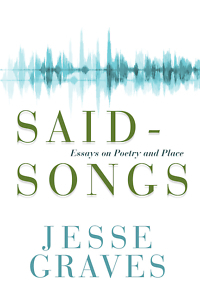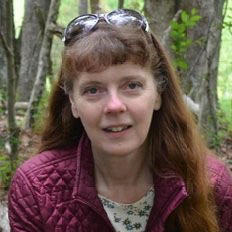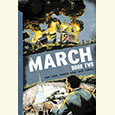Always a Circling Back
Jesse Graves’ Said-Songs explores the mysteries of poetry and place
In a chapter of Jesse Graves’ Said-Songs: Essays on Poetry and Place in which he discusses mid-20th-century Knoxville author James Agee, Graves evokes his own childhood in Sharps Chapel, Tennessee, about 40 miles north of Knoxville.

“I grew up in a remote, essentially eerie place way out in the country, with no neighbors or lights from other houses in sight,” Graves writes. “The evenings were quiet, and my mother and I often sat on the front porch and listened for bobwhites and whippoorwills in the summer.” Amid unknown “noises and shadows and changes in the atmosphere,” Graves sensed that he was “surrounded by mysteries of every kind.”
That the East Tennessee State University professor chose his own memories as a way to engage with another author’s work is typical of this collection of essays, interviews, and reviews, which Graves says represents his youthful attempts “to learn the mysteries and designs of poetry.” First reading Agee’s 1938 poem-essay, “Knoxville: Summer 1915,” as a college freshman at the University of Tennessee, Graves felt he had “seen through a window” into his own boyhood up the road.
It’s clear throughout this collection that both reading and writing are personal acts for Graves. The book’s title comes from poet A.R. Ammons, one of Graves’ heroes, who used the phrase “said-songs” to describe “the music of speech” in poems about the Carolinas. Reading them, Graves perceived the music of the country speech he had grown up with and adopted the phrase.
 Said-Songs is comprised of five sections, each deftly blending a subjective voice with an analytical one. The first section explores Graves’ own journey, inspired by other Appalachian writers, as well as poets such as William Wordsworth, whose work is deeply rooted in place. One of his primary concerns is “what to do with the memories of people and places that are now lost to me,” writes Graves, now author of four collections of poetry. This includes not only deaths in the family but displacement such as Graves’ ancestors experienced in the 1930s when the Tennessee Valley Authority flooded farmland to build dams.
Said-Songs is comprised of five sections, each deftly blending a subjective voice with an analytical one. The first section explores Graves’ own journey, inspired by other Appalachian writers, as well as poets such as William Wordsworth, whose work is deeply rooted in place. One of his primary concerns is “what to do with the memories of people and places that are now lost to me,” writes Graves, now author of four collections of poetry. This includes not only deaths in the family but displacement such as Graves’ ancestors experienced in the 1930s when the Tennessee Valley Authority flooded farmland to build dams.
The second section examines the work of other Southern writers, including Robert Morgan, Ron Rash, Maurice Manning, Jeff Daniel Marion, Karen Salyer McElmurray, and Nancy Peacock. Place is a recurring theme here, too, but its definition is intriguingly stretched in the transcript of a 2014 discussion of McElmurray and Peacock’s blog Marginalia, in which the digital form is seen as a new kind of “place” that eliminates the boundary between public and private.
Graves’ third section explores poetry and music, examining poetic sequencing in the album Josephine by Magnolia Electric Co., musicality in the poetry of David Bottoms, and the concept of the sublime in John Ashbery’s work. Again there is an interest in modern media. “Contemporary poetry and independent roots music move through contemporary culture like two branches of the same river,” Graves writes. Each has been “set adrift from their traditional methods and outlets of distribution” by the Internet. Referencing Bottoms’ point that the poet’s role is akin to that of radio, Graves says each is “a receiver for the offerings of the world, and … a transmitter of the messages received.”
Part four focuses on Agee — Graves’ neighbor in space if not time. “Knoxville: Summer 1915,” he says, alerted him to the idea that he had been born in the perfect place to become a poet. “When I read Agee, I could not believe that something so beautiful had been written about my part of the world, about a place I knew so well, and the people who lived there.” Beauty is also a theme of his chapter on Let Us Now Praise Famous Men, Agee’s 1941 book about Alabama tenant farmers during the Depression. Originally a Fortune magazine assignment, Agee’s book presents the farmers as having a “fully integrated place in the world,” rather than as sentimentalized victims of circumstance. Referencing critical work on Agee’s ethics, Graves argues that aesthetics matter, too. For Agee, “[T]he ethical and the beautiful cannot be separated through either intention or accident.”
The fifth section, “Surveying the Land of the Word,” is comprised of previously published reviews and interviews, including one with Chapter 16.
Although Said-Songs is an academic book, reading it feels like sitting on a wide Southern front porch — perhaps like Graves’ mother’s — and engaging in conversation with an unusually thoughtful friend. The prose is earnest and sincere and full of observations like this one: “Imagination must move through a poem like blood through a body, the animating force unseen from the outside.”
As for reading, Graves says, “[T]here is always a circling back, and you will not be the same reader you were the first time you passed this fork in the road.”
That is no doubt true.

Jane Marcellus is a writer whose published work includes literary nonfiction, critical analysis, and journalism. Her work was listed as “Notable” in Best American Essays 2018, 2019, and 2020.


